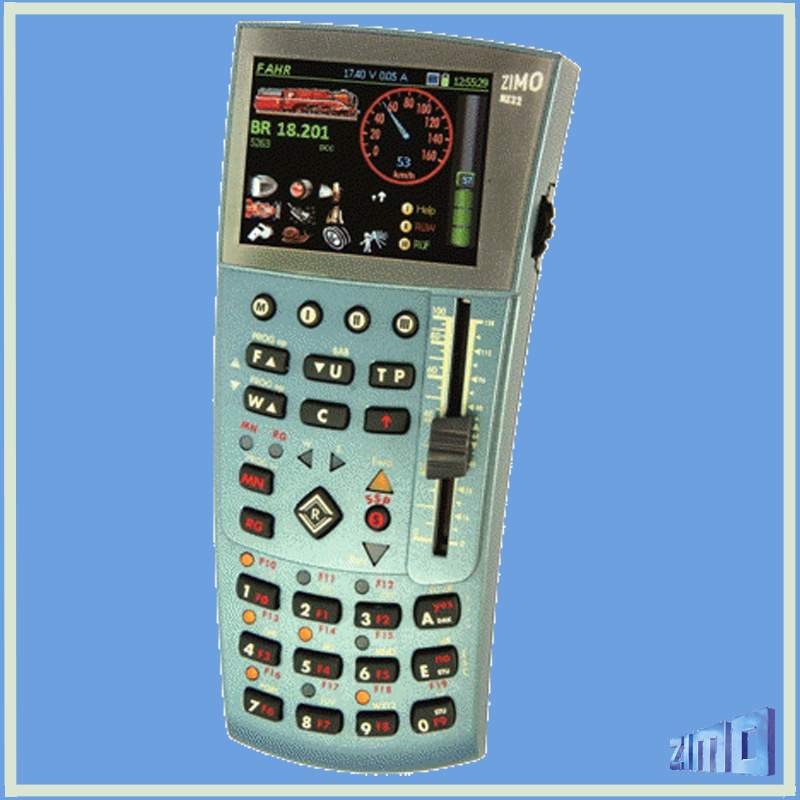
$450.00
|
THE MX32 Handheld The MX32 (and its wireless version MX32FU) are themost important interface to your ZIMO digtial multi train control system. It is used in conjunction with the ZIMO DCC central station (command station) MX10, but they can also be utliized wiht the previous ZIMO generation (ie. MX1, MX1HS, MX1EC) or even with the ROCO command station Z21. Technical Specifications Current draw (bei 20 - 30 V am CAN Bus - Kabel )………………………………………… 70 mA The exterior Design of the MX32 Th ealready popularized "edgy" design of the previous generation handheld (MX31) was the basis for the new handheld. Small changes further enhanced the operation of the unit. The principal of the design was the duality of using it has a handheld as well as a tabletop unit. Many hobbyists fell already in love with this type of handheld design. The outer feature of the innovation is the OLED-Touch-screen with the size of 2.4" and a resolution of 320 x 240, but the inside is also revolutionized new technolgy.
The wired MX32 In addition to the MX32 there is also the wireless version MX32FU and the mini central station version MX32ZL.
Software-Update via USB-Stick The USB host interface allows the insertion of regular USB sticks into the handheld, and hence enables easy software updates, or loading of your own personal picture files, as well as personalized customization, such as switch yards, operational languages, and engine functionality. Future functionalites include the transfer of new datasets via the CAN-BUS automatically among the various command stations.
RailCom: The handheld doesn't need special hardware for "RailCom" becasue all the detectors are in the comand station or in the decentralized local detectors. The Railcom information is wirelessly (or wired) tranmitted to the handheld. RailCom, is the ability to send information back to the command station which is for ZIMO an integral part of the new system technology. Of course you can operate still decoders that don't offer RailCom connectivity (but what is the fun in that?). ZIMO's decoders offer the top RailCom interface capabilities (go beyond just announcing CV valaues and the engine address) and they have the ability to be constantly upgraded (necessary because RailCom will receive constant enhancements). RailCom is also the basis of "self announcing" trains, when they are added first time to the layout. This avoids complications from forgotten addressen and CV values.
The operational concept of the MX32 The positioning of the keys is derived from the positive experience of the MX31 generation. But the operational and programming interaction offers more information and comfort based on the large color display. At the heart of the MX32 is a powerful 32-bit-Micro processor with a large storage (RAM and Flash together are several GB): you can store engine pictures, function-key icons (even animated), analog speedometer, color coded speed controler indicator, and so much more. The software was designe din such a way that users will not require to study lengthy user guides, but can start intitivley operate the unit. Context senitive interactive information is always available and many functions also offer on-the-fly help screens,that inform about the current steps of the activity, such as the current meaning of hte softkeys, or other configurable keys. Of course the MX32 offers also a set of conventional keys allowing to quickly utilize the most imporatant functions. there the touch screen is most useful for changes to the display of information (ie. small or large engine picture, change of the speedometer type, swithcing the turnouts, and more...) In the operations mode DRIVE (FAHR) RailCom enables to reliable connection to the engine, and threfore the real-time speed, the motor load, the calculated break distance are announced reliably. Additonal operational importance have the "Program in Service Mode" or "Program on the Main" activities. Additionally non-ZIMO decoders are also supported, and the guided CV programming will assist in changing the engine's paramters. RailCom changes the expectation of PoM operation becasue unlike the past the CV values are reproted back to the handheld.. The operation mode SW (WEI) has been named for traditional purpose. This mode allows to switch turnouts or signals from visial interface, and allow the control change via the touchpanel or the the keyboard interface. Future enhancements is the introcuiotn of automatic operations (ABA) as well switch arrays as well as "mini" switch yard pictures on the handheld, ptential in conjunction with computer control software such as STP or ESTWGJ. |
|
Please wait! Content loading.....
